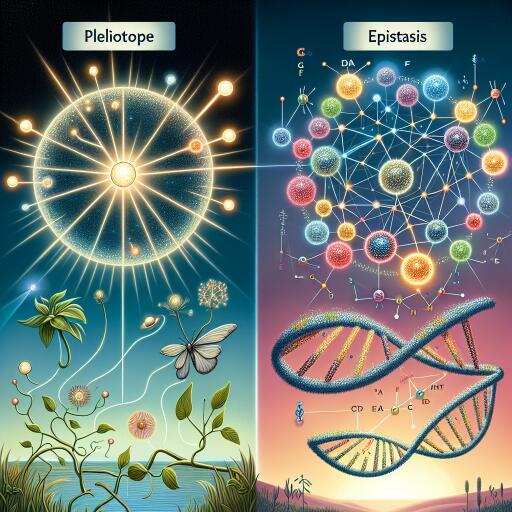Exploring the Complexities of Pleiotropy and Epistasis in Quantitative Traits
The study of genetics has long fascinated scientists and laypeople alike, offering insights into the blueprint of life itself. Among the various phenomena that captivate researchers are pleiotropy and epistasis—two aspects of genetic architecture that play crucial roles in shaping the observable traits or phenotypes of organisms. This article delves into the concepts of pleiotropy and epistasis, their detection and quantification methods, and their evolutionary significance. We also shed light on the differences observed between genetic model organisms and human populations, aiming to unravel some of the complexities inherent in genetic studies.
Defining Pleiotropy and Epistasis
Pleiotropy occurs when a single gene influences multiple phenotypic traits. This phenomenon can manifest in two forms: horizontal pleiotropy, where a gene variant affects multiple traits independently, and mediating pleiotropy, where a variant influences one trait, which in turn affects another. An intriguing example of horizontal pleiotropy is observed in mammals, where certain gene mutations impact both coat color and auditory functions. Mediating pleiotropy is exemplified by the relationship between low-density lipoprotein (LDL) cholesterol levels and coronary artery disease (CAD), where high LDL cholesterol acts as a causal risk factor for CAD.
Epistasis, on the other hand, refers to the interaction between genes, wherein the effect of one gene is modified by one or several other genes. These interactions can significantly influence the expression of phenotypic traits and complicate the genetic architecture of organisms.
Detecting and Quantifying Pleiotropy and Epistasis
Detecting pleiotropy and epistasis involves utilizing a variety of methods, ranging from traditional genetic crosses to modern genomic techniques. Model organisms, such as yeast, flies, and mice, have been instrumental in facilitating the identification of genes affecting phenotypes of interest. The availability of mutation collections and RNA interference (RNAi) constructs has enabled large-scale screenings to quantify pleiotropy across diverse studies. Interestingly, these investigations have revealed that while some mutations exhibit high levels of pleiotropy, affecting a wide array of traits, others have more limited effects.
In human populations, genome-wide association studies (GWAS) have become a crucial tool for examining the genetic basis of quantitative traits and diseases. These studies have uncovered significant pleiotropic relationships between traits, sometimes in unexpected ways, highlighting the shared genetic architecture underlying various human conditions. For example, genetic links have been identified between psychiatric disorders such as schizophrenia and bipolar disorder, illustrating the complexity of genetic influences on human health.
Evaluating Pleiotropy and Epistasis in Evolution
The evolutionary consequences of pleiotropy and epistasis are profound. Pleiotropy, by linking traits together genetically, can have a significant impact on the evolutionary trajectories of organisms. For instance, antagonistic pleiotropy, where a genetic variant has opposite effects on fitness at different life stages or in different environments, can contribute to the maintenance of genetic variation within populations. This phenomenon has been observed in various model organisms, including Escherichia coli, Saccharomyces cerevisiae, and Drosophila melanogaster.
Similarly, epistasis can influence the path of evolutionary change by creating genetic interactions that affect the fitness landscape. Such interactions can lead to complex adaptive strategies, further underscoring the intricate relationship between genetic architecture and evolutionary dynamics.
Concluding Thoughts
The concepts of pleiotropy and epistasis highlight the intricate and interconnected nature of genetic architecture. By understanding these phenomena, researchers can gain deeper insights into the genetic basis of quantitative traits and the evolutionary forces shaping genetic diversity. Despite the challenges posed by the complexity of these interactions, advances in genomic technologies and analytical methods continue to enhance our understanding of the genetic underpinnings of life.
As research progresses, the exploration of pleiotropy and epistasis will undoubtedly shed light on the mysteries of genetic variation and the mechanisms of evolutionary change. It underscores the significance of genetics in decoding the tapestry of life, offering a window into the multifaceted interplay between genes and traits that define the living world.










